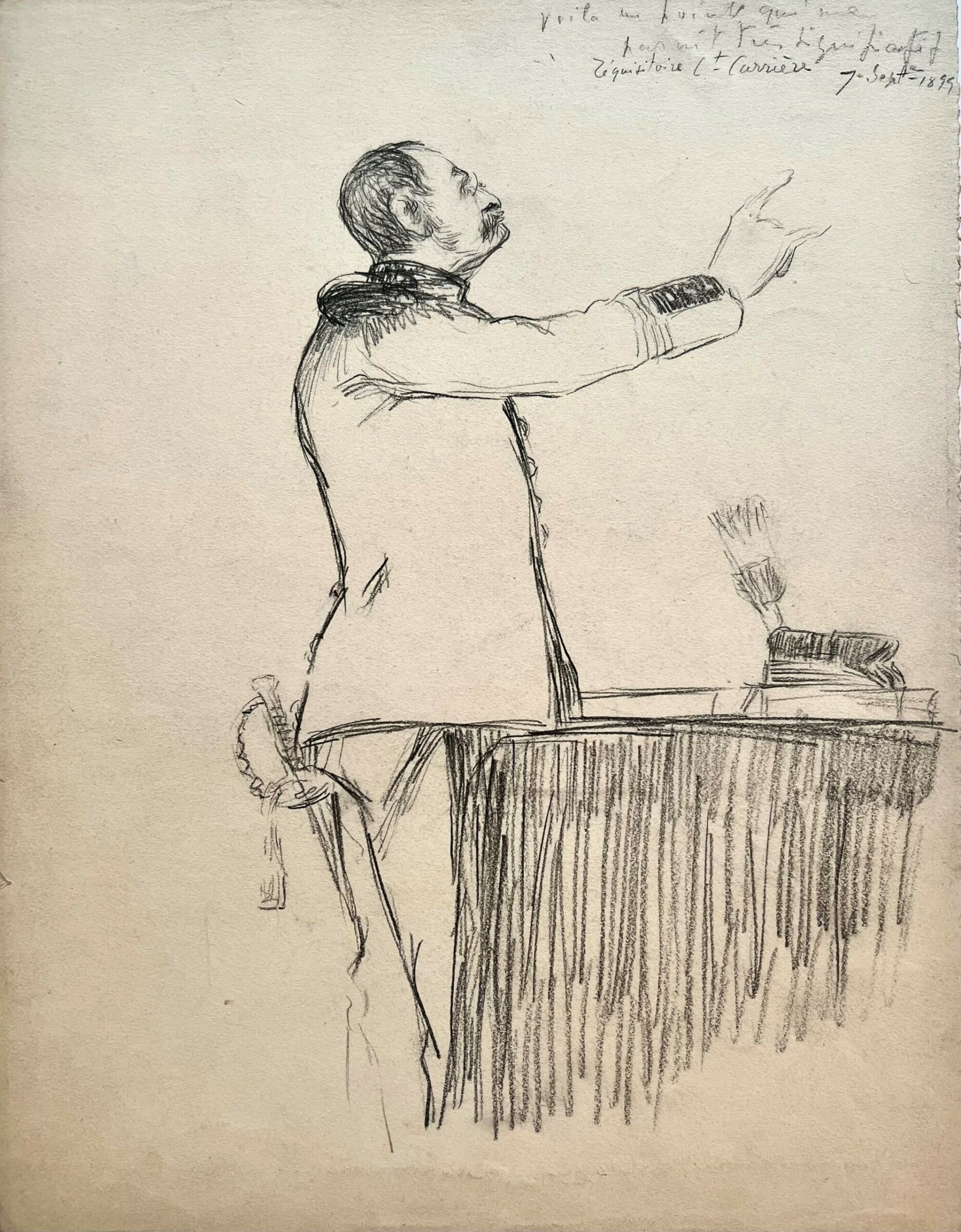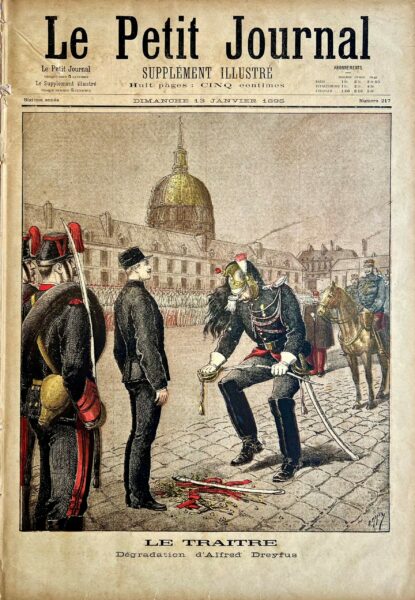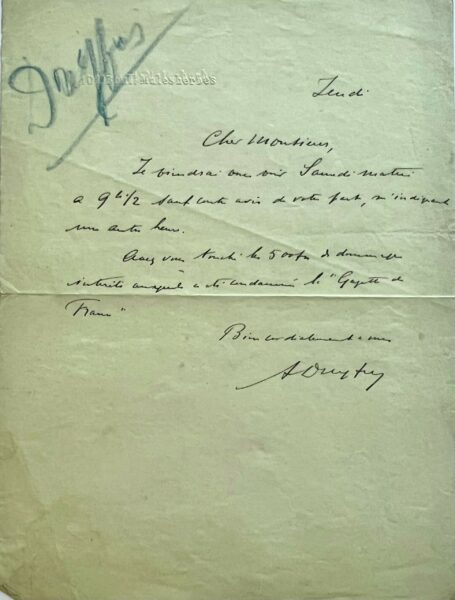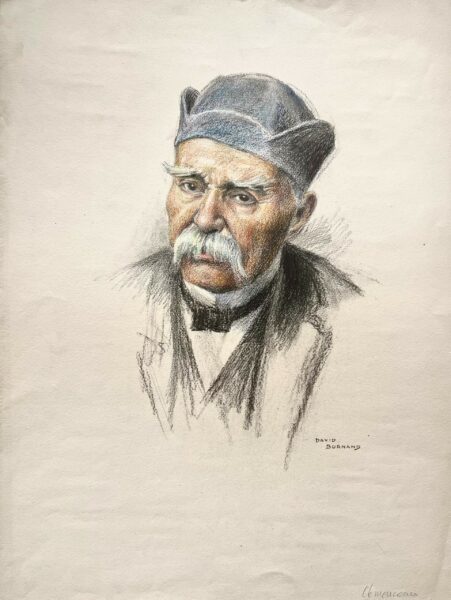[DREYFUS, AFFAIR.] BOUCHOR, JOSEPH-FÉLIX. (1853-1937). French portrait artist. Drawing 1p. Large 4to. (approx. 12 ½” x 10”). [Rennes], September 7, 1899. Bouchor’s eye-witness courtroom pencil sketch depicting a uniformed Major Louis-Norbert Carrière (1833-?) standing before a table with his arm upraised. A handwritten note in the upper right corner reads “Here’s a senior officer that seems very unambiguous to me / Major Carrière’s indictment 7 September 1899.”
Alfred Dreyfus’ 1894 conviction for treason and his subsequent exile and imprisonment on the French Guiana penal colony Devil’s Island hinged on an intercepted memo, or bordereau, which revealed French military secrets that had been sent anonymously to the German embassy’s military attaché, Captain Schwartzkoppen, in Paris. The memo’s actual author was French Major Marie-Charles-Ferdinand Walsin-Esterhazy, a spy in German employ. Additional evidence, intended to implicate Dreyfus, was secretly forged and submitted by French Army officers to the military judges presiding over the proceedings.
The truth finally emerged in the summer of 1898 after Lieutenant Colonel Hubert-Joseph Henry confessed to his forgeries and killed himself in a military prison and Esterhazy fled to England. General Boisdeffre, the army’s Chief of the General Staff who had been convinced of Dreyfus’ guilt from the beginning, resigned after Henry’s confession. Considering these events, the court annulled the 1894 judgment against Dreyfus and granted him a second military trial in Rennes. Dreyfus, frail and in poor health, sailed from his island exile on June 9, 1899, to appear at the Rennes trial on August 7th.
Journalists and artists from around the world swarmed Rennes to observe the trial that would be “a culminating point of l’affaire. It was the last opportunity for the military system of justice to redeem itself… The first military tribunal [in 1894] had been able to insist that no hearings be conducted publicly. At Rennes, the second military tribunal held all hearings publicly, except for one, and the fact that the court insisted on holding any at all behind closed doors both exacerbated criticism of the proceedings and was hotly contested by the defense, for this time the eyes of the country and of the world were fixed on Rennes. The world press was ready to convict France if France convicted Dreyfus. And France itself, author of the Rights of Man and Citizens, country of the philosophes, and of the Enlightenment, was only too painfully aware of this,” (“The Military Trial at Rennes: Text and Subtext of the Dreyfus Affair,” Touro Law Review, Curran). The trial was covered in detail by newspapers and magazines worldwide and was even dramatized in Georges Méliès series of short silent films, produced concurrently with the trial to become the first ever film serial! (Nine of the eleven films can be viewed here: https://www.youtube.com/watch?v=Y3Re6Y1G8_U).
“By the time the Rennes trial took place, proof of his innocence abounded,” (The Affair: The Case of Alfred Dreyfus, Bredin). He was defended at court by prominent criminal attorney Ferdinand Labori, who had defended Emile Zola after his famous publication of J’Accuse…! One week into the trial, on August 14, Labori was shot in the back by a would-be assassin on his way to the courtroom. Though badly wounded, he returned to court on August 22. During the trial “Dreyfus spoke at length, and always confidently and with impressive specificity and precision, reconstituting events, showing how and why his accusers could not be telling the truth… On numerous occasions throughout the trial, he broke out in protest against the injustice and inaccuracy of testimony and, as he put it, its calumnious nature,” (op. cit., Curran).
Carrière had retired from the military in 1889 but was appointed government commissioner to the court martial in Rennes in 1892. An anti-Dreyfusard, “Officer Carrière deliberately misunderstood the instructions from Paris. He allowed points that had been ruled out by the 3 June 1899 decree to be debated, and he subjected the witnesses for the defense to abuse. Meanwhile, the seventy witnesses for the prosecution who were called, even if they had ‘no personal or direct knowledge of a pertinent fact,’ spoke under the influence of General Mercier. Affirming that the trial was a struggle, Carrière benefited from a freedom to speak since his ministry had not given him any written pleadings,” (“Louis-Norbert Carrière,” 1906 Dreyfus Rehabilitated, http://www.dreyfus.culture.fr/en/bio/bio-html-louis-norbert-carriere.htm.
On September 7, “Carrière delivers his closing speech… [which] reiterates the arguments of the General Staff in confused and disorganized manner. He ends with an affirmation of the guilt of Dreyfus and demands the application of Article 76 of the Penal Code… Carrière’s speech provoked laughter among the public and was considered by most observers extremely weak, full of unfounded hypotheses and lacking in substance. [General Auguste] Chamoin confided in [Maurice] Paléologue [of the Foreign Office] that day: ‘After a closing speech for the prosecution of such total nullity the acquittal of Dreyfus is certain. I have just telephoned General de Galliffet to tell him.’ Paléologue replied: ‘And I have just telephoned M. Delcassé to say that a conviction is inevitable,’” (The Dreyfus Affair: A Chronological History, Whyte).
Indeed, the efforts made by Dreyfus’ lawyers to prove their case with witnesses and overwhelming evidence that pointed to a broad conspiracy to frame Dreyfus, failed. On September 9, the judges, by a majority of five to two, found Dreyfus guilty of treason under the absurd concept “extenuating circumstances,” and sentenced him to ten years detention. Ten days later President Émile Loubet issued Dreyfus a pardon. Dreyfus, initially opposed to accepting any pardon as it would have compelled him to withdraw his petition for a legal revision and acknowledge responsibility for a crime he steadfastly maintained he never committed, finally acquiesced, providing he could still try to clear his name.
Despite the ongoing vitriolic attacks in the press and public displays by anti-Dreyfus elements, the Court of Cassation finally declared Dreyfus innocent 1906. The Dreyfus Affair’s significance is so far-reaching that the human rights movement, the origins of modern-day Zionism (Theodor Herzl was in Paris covering Dreyfus’ first trial for his Viennese newspaper), and the French separation of church and state can all claim to have been born during this dark chapter in French history.
Educated at the Beaux-Arts and an exhibitor at the Salon des Artistes Francis, Bouchor became known for his portraits of General John Pershing and French President Georges Clemenceau (a supporter of Dreyfus and publisher of Zola’s “J’Accuse…!”) as well as his illustrations of the American Expeditionary Forces in World War I and Orientalist paintings inspired by his travels in North Africa.
Provenance: Isabelle Lazar (nee Grumbacher), wife of Jewish journalist Bernard Lazare, anarchist, literary critic and one of Dreyfus’ earliest and most vocal defenders who covered the Rennes trial for The Chicago Record and The North American Review.
In very fine condition.





